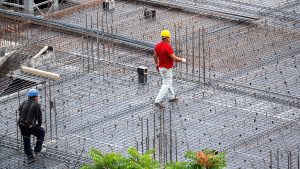Introduction
A crucial stage in the construction process is how to build a concrete slab foundation for a house. It gives the home a safe and level foundation, guaranteeing its defense and security. Here are some more detailed actions to take:
Soil Preparation
Assessing the soil quality on your location is crucial before starting any foundation work. Your house’s weight must be supported by the earth without any settling or jerking. An expert geotechnical engineer can offer a soil analysis that describes the state of the soil and any remedial actions that are required.
After evaluating the state of the soil, the next stage is to clear the area of any trash, rocks, or plants. The dirt must then be compacted and the surface leveled. Either a compactor machine or a heavy item can be used to compact the dirt.
Building the Formwork
The formwork that will hold the concrete must be constructed next. The formwork, which is made up of steel or wooden pieces, forms a mold around the foundation’s edge. The formwork should be the same height and shape as the foundation of your home.
Measure the foundation’s dimensions and cut the boards or panels to size to make the formwork. To avoid movement during the concrete pour, the formwork needs to be square and level with the sides braced.
Adding Reinforcement
In order to offer concrete strength and durability, reinforcement is necessary. The most common form of fortification used for concrete portion foundations is steel rebar. Within the formwork, the rebar is arranged in a grid design and secured with wire or plastic ties.
The size and weight of your home will determine how much reinforcement is needed.
A design specification that specifies the needed quantity and location of reinforcement can be offered by a qualified engineer.
Pouring the Concrete
Concrete should be poured once the formwork and support are in place. The manufacturer’s instructions should be followed when mixing the concrete, and it should be poured into the formwork in portions.
Use a concrete vibrator to remove any air pockets and settle the concrete to guarantee a smooth and level surface. The concrete is leveled with a slurry board, and the surface is smoothed with a bull float.
Finishing the Surface
After the concrete has been smoothed, the surface can be finished. To achieve various textures and degrees of grip, a variety of finishing methods can be used. A broom can be used to create a rougher surface that offers more grip, or a trowel can be used to create a smooth surface.
Curing the Concrete
An integral part of constructing a concrete slab base is curing. Concrete can attain its maximum weight and durability after curing. For a minimum of seven days, the concrete needs to be kept wet and at a constant temperature. This can be achieved by keeping the pavement moist and covering it with plastic sheeting or wet burlap.
Removing the Formwork
It’s time to take down the formwork after the concrete has dried. To prevent the concrete from being harmed, the formwork should be meticulously removed. The boards or panels can be taken down using a hammer or pry tool. After the formwork has been taken down, check the base for any flaws or cracks.
Inspecting the Foundation
The foundation must also be checked by a qualified building inspector to make sure it complies with all applicable building codes and laws. The examiner will examine the foundation to ensure that it is square, level, and that the reinforcement and thickness standards have been met.
In conclusion, creating a concrete slab foundation for a home is a complex process that needs careful preparation and execution. You can produce by doing the following:

Leave a Reply